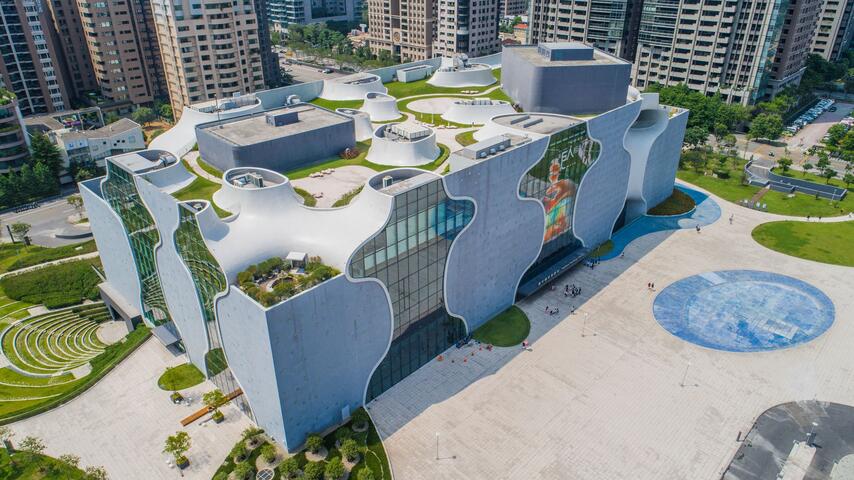National Taichung Theater Introduction
The Taichung National Opera House features a cutting-edge design based on the concept of a "Sound Cave," incorporating unique features such as curved walls, holes, and tubular structures. The entire building lacks any supporting beams or columns, and no wall surface is at a 90-degree angle, challenging conventional architectural concepts. After years of development, a theater that coexists with people and nature is about to be born in Taichung. With its arc curves, it quietly nurtures everyone's anticipation; its glass curtain reflects the blue sky, while the surrounding green spaces and flowing water create an urban paradise. The façade of the "Sound Cave" resembles a curvaceous wine jug, inviting audiences to be intoxicated by the brilliance of performances and marvel at the endless possibilities of art. The multiple cylindrical windows embedded in its structure radiate elegance and warmth at night when illuminated. This space is a cradle for performing arts, a place for people to relax and absorb new knowledge, and a starting point for the cultural revival of Central Taiwan. This is the Taichung National Opera House. Beautiful things undergo ample preparation, especially one that embodies art and culture into life. In 1992, the Education Department of the Taiwan provincial government planned the "National Taichung Music Arts Center," which was later changed to "National Concert Hall," aimed at establishing an internationally standard performing arts center in Taiwan. After meticulous revisions of the venue's scale and name, in 2005, the construction project for the "Taichung Metropolitan Opera House" was officially approved by the Council for Cultural Affairs (now the Ministry of Culture). With the construction project confirmed, the architectural design proceeded via an international competition involving teams from 13 countries (32 architects) including Taiwan, Japan, the United States, the United Kingdom, and France, conducted in two phases. Ultimately, Japanese architect Toyo Ito emerged as the winner. With a clear outline of the venue's architecture established and long-term preparations having amassed sufficient energy, the opera house set its direction for operating as an international-level venue in Taiwan. From the initial design to the building's completion, the opera house has undergone rigorous testing and refinement. During the competition phase, Toyo Ito employed avant-garde design perspectives that challenged existing cognitive patterns, envisioning the building's outline in advance and incorporating the stage into the curved walls based on performance characteristics. The second phase focused on spatial efficiency, evaluating feasible structural design solutions and innovatively connecting the main auditorium with the medium-sized theater's lobby. Ultimately, based on the internal visual and auditory experiences of the opera house, slight adjustments were made to the pathways, returning attention to the interaction between "people" and space, emphasizing the artistic energy that resonates within the "Sound Cave." The laughter, sorrow, and emotion that performing arts aim to present thus gain enhancement and amplification in this space. The Taichung National Opera House features 58 curved walls, each made up of 1,372 small components that require custom fabrication, making mass production impossible—this represents an immense undertaking requiring precise calculations. Due to the extreme difficulty of constructing the Taichung National Opera House, it has been referred to as "the world's most difficult building to construct," with its "curved wall" construction method awarded world patent certification. The interior space of the Taichung National Opera House includes a large theater (2,007 seats), a medium theater (794 seats), a small studio (200 seats), as well as an underground parking lot and related public spaces. The surrounding landscape design is also comprehensively planned with the concept of the Sound Cave. Each of the 2,014 seats within the opera house can experience the same auditory feast, and there are no visually obstructed areas; every seat has a clear view of the stage. The spaces akin to treehouses or caves do not lead people back to the past but use modern technology and materials to liberate the harsh, cold environment, transforming the rigid outlines of the city into a soft, vibrant field full of life. The flowing water and open imagery of the air gardens surrounding the venue break down the binary distinctions between stage and audience, indoors and outdoors, reestablishing the increasingly lost sensitivity to the environment among modern individuals, and creating more possibilities for dialogue between people, architecture, and art. The "greatness" of architecture does not lie in the amount of steel, concrete, and glass used to construct a massive outline. In the past, people relentlessly pursued the highest and most magnificent buildings to demonstrate the potential of human victory over nature. Today, however, there is an attempt to discover principles of coexistence with nature and the environment, returning to the fundamentals of life—concerning the feelings of "people." Everyone actually yearns to tell stories, listen to melodies, move their bodies to the rhythm of dance, and appreciate the unmatched splendor of traditional arts; these are the true "greatness" that the Taichung National Opera House takes pride in. Coexisting with nature, the fluid space warmly embraces humanistic arts. The curved walls, resembling bones, and the transparency of the glass curtain allow sunlight to naturally pour in, with breezes effortlessly flowing through; at night, these holes emanate warm halos of light, giving rise to the breath and life of the Taichung National Opera House. Additionally, the Taichung National Opera House features a green park, with even the drainage ditches in the park extending into the building, blurring the boundaries between indoor and outdoor spaces.








































